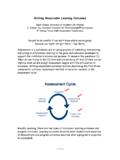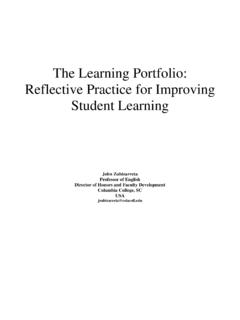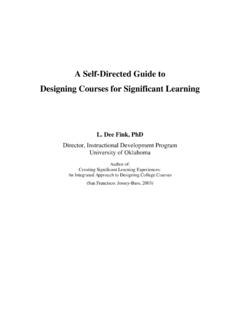Transcription of Student outcomes assessment of a l ogistics and …
1 Journal of Case Studies in Accreditation and assessment Student outcomes assessment of a llogistics and supply upply chain management major Clyde Kenneth Walter Iowa State University ABSTRACT. assessment of specialized programs, such as the logistics and supply chain management program described here, may pose challenges because previous experiences are less widely shared than in the more mainline subjects. This case study provides one model that may guide other faculties facing a similar assignment assignment. The report details the steps followed to assess an undergraduate program in Logistics and Supply Chain Management. The starting point was a two-stagecourse-mapping,, which identified strengths and weaknesses of course coverage compared to college goals, and also compared to a set of topic areas recommended by faculty facul members. Next in the process was a survey of graduating students who responded to questions about basic concepts in their recently completed courses.
2 The assessment was considered useful in providing a feedback path necessary for faculty to close the loop in course design and teaching. In addition, this case study showed how a process from a small liberal arts college may be adapted to a narrowly focused business program in a larger and more diverse university setting. Keywords: outcomes assessment , ment, college of business, education, major, logistics, supply chain Student outcomes assessment , Page 1. Journal of Case Studies in Accreditation and assessment INTRODUCTION. A minority of 475 accredited colleges of business offer specialized curricula in logistics and supply chain management. Ozment and Keller (2011, p. 77) identified 65 bachelors bach degree granting programs, resulting in a discipline simply not large enough to provide an adequate number of graduates to meet the managerial needs of American business. Pohlen (2011, (2011 p. 85). traced this need back 50 years and concluded, Today, th thee need for educating transportation and logistics professionals is as pressing and important as in 1960.)
3 To ease the burden of creating new programs, Naim et al. (2000) provided a course template that may be adopted, and adapted, for the educational needs ds of the modern and future logistician. This paper provides a logical continuation for the logistics educators who next will need to assess the achievements of their programs so that necessary changes can be identified. The assessment instruments developed devel by logistics and supply chain management faculty at Iowa State University are provided for the adoption or adaption by colleagues at other institutions who may save considerable time by following the steps described, even including similarly worded qu questions estions in Student surveys students . As a secondary objective, the project demonstrated the feasibility of applying assessment techniques from widely different educational environments to non non-standard standard programs. BACKGROUND. Alverno College vs. Iowa State University Called the single hot topic in higher education (Allen, 20042004, p.)
4 93), ), the origins of post- post secondary outcomes assessment have been attributed to two decades of experience at Alverno College in Milwaukee (Mentkowski, 200 2000, pp. xvi-xvii).. Alverno's assessment of students and alumni began by identifying strengths and weaknesses of its approach to teaching, first by interpreting the contributions of students ' total college experience, and then through a dialogue on the lasting ing effects of learning as it influences all aspects of their graduates' lives. The Alverno faculty approach to learning that lasts recognized that their graduates faced both traditional and non-traditional traditional roles as thinker, leader, parent, and citizen citizen (Mentkowski, 2000, 2000. pp. 4-5). Riordan (2005, p. 52), ), an Alverno College faculty member, was more succinct: the aim of teaching is to help students get to the point where they don't need us. But can a concept developed at a small--2,759. 2,759 undergraduates (Alverno, 2011)--Franciscan Franciscan women's liberal arts college be applied to a narrowly focused logistics and supply chain management curriculum at a state university ten times as large?
5 The Iowa State University University, College of Business (2010) Strategic Plan defines def the core value of its teaching as providing students the skills and experiences needed to succeed in a complex, technology-driven, driven, global society. assessment of Student outcomes is integral to the college-wide plan and incorporated directly in the associated goal of strengthening undergraduate education to improve mprove Student learning experience and performance on college learning outcomes across the curriculum curriculum.. For the 2010 spring semester, tthe business college enrollment of 3,226 included 126 1. students ents majoring in Logistics and Supply Chain Management, making it one of the smaller majors in the college. By contrast contrast, the more popular traditional majors of finance (402), (. marketing (411), ), and accounting ((440) each ach attract three times as many students (Iowa State Student outcomes assessment , Page 2.))
6 Journal of Case Studies in Accreditation and assessment University, Office of the Registrar, 2010). 0). In the competition for Student awareness, faculty in a smaller program are very cognizant of the vulnerability of their curriculum. Since little has been published lished about assessing logistics programs specifically, it was necessary either to adapt previous , , general business knowledge or standardized test bank questions for selected textbooks (Downing 2010, McGraw McGraw-Hill 2010)--or develop the balance ce of the process from scratch. The latter approach was chosen, consistent with Allen's (2004,, p. 94) 94 criticism of standardized assessment because it tends to miss the best features of a program.. (and) .. promotes a tendency toward checklists .. and cookie-cutter cutter approaches for reporting. Fenwick (2001, p. 68)) also was critical of standardized testing because of its focus on recall and formulaic problem solving that is isolated from learning contexts contexts.
7 Diverse objectives of assessment outcomes assessment supports a broad educational objective, such as that of California State University, Fresno (2010):: to advance Student learning through improved curricula and instruction. assessment is taken at the behest of a diverse set of organ organizations: izations: state governments, accrediting boards, and university administrations. Allen (2004, pp. 94-95) 94. challenged these mandates as sometimes generating useless information that cannot be tied to program improvement but she supported assessment that was the result of faculty asking, Does what we do matter? She recognized Student outcomes assessment ultimately having hav a broader purpose, as a tool to improve the quality of the field overall, as individual programs test or recognize the means to enhance ce their effectiveness effectiveness. Fenwick (2001, p. 63)) viewed Student outcomes as one dimension of a multifaceted program of faculty evaluation.
8 She recognized the differences between learning and good teaching, and cited studies that explained in explained addition to teaching--the the institutional, dispositional, and social influences on learning. In contrast to measuring individual teaching effectiveness, Wergin (1999(1999, pp. 1, 4)) studied how academic departments were evaluated by their institutions. He noted widespread discontent, and concluded, The way an institution sees itself is reflected in how it evaluates. Riggio, Mayes and Schleicher (2003, p. 68)) defined a narrower role for outcomes assessment to demonstrate the career readiness of college graduates.. ommon grounds for assessment Common The body of work on Student learning assessment introduces a more more-or-less less common set of terms. One sample set is California State University, Fresno's Local Lexicon of assessment Terms (2009). Another often-cited cited list is from Martell and Calderon (2005, p. 2), who defined assessment as an ongoing process aimed at understanding and improving Student learning.
9 They further explained the requirements of assessment to: (a) identify learning goals and objectives .. : (b)) set meaningful expectations .. ;. (c) systematically gather, analyze, and interpret evidence to determine how well performance matches those expectations and standards; and (d) use the resulting information to document, explain, and improve performanc Student outcomes assessment , Page 3. Journal of Case Studies in Accreditation and assessment AACSB assessment support The accreditation body for colleges of business, AACSB International, has sponsored conferences on assessment and published a twotwo-volume volume series of best practices papers (Martell and Calderon, 2005, p. 15). The organization explains its Assurance of Learning (AOL). standards, which require business schools to state their learning goals and demonstrate how they will improve their degree programs using evidence collected through direct measures (Trapnell, 2005, p.
10 Iii). The direct approach is based on demonstrations of knowledge by students , whereas an indirect approach might survey alumni or their employers about the learning obtained by a program's students . A repeated term in outcomes assessment literature is closing the loop, . considered the most important part of the assessment process in the accreditation process (Martell and Calderon, 2005, pp. 5, 88). assessment experiences of business schools With accreditation as the driver, numerous business scho schools ols have taken the initiative to adapt the Alverno College assessment model to specialized programs in different settings. One documented example is the Girard School of Business and International Commerce at Merrimack College in Massachusetts, which tractraces es its assessment program to the 2002 adoption of 12 learning outcomes , divided evenly between general knowledge and abilities and business-specific specific knowledge and abilities (Popper, 2005, p.

















